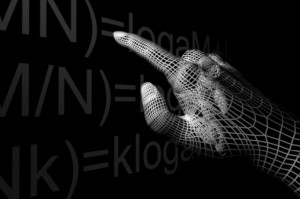The Power of Networks (Part 10)
By Asher Crispe: February 27, 2013: Category Inspirations, Networks of Meaning
We have attempted to establish in the previous article how our network is ‘carried’ by means of four modalities. Now we will focus on how Domains, Links, Search and Programability can be granted ontological significance as they relate to four natural modes of Being.
 Where does the word ‘Domain’ come from? Etymologists trace it back through the Old French demeine (‘belonging to a lord’) to the Latin dominus or ‘lord’ or ‘master.’ In Hebrew, on account of the Tetragrammaton being unpronounceable outside of highly circumscribed conditions, the tradition has been to substitute this ineffable name for the name Ado-nai (also augmented in its pronunciation outside of a liturgical context and appears in variations such as Adni, Adnut, or Adokai etc…) which is commonly translated into english as “Lord.” When situating this name amongst other Divine names, it usually corresponds to the sefirah (channel of Divine self-expression) of malchut (kingdom). Of the four letters of the Tetragrammaton (Yud-Hei-Vav-Hei), this name and channel corresponds to the final Hei. In short, a kingdom is a Domain–a region with a master or control figure. In common parlance, the person who practically oversees the day to day functions of a Website is called a Webmaster. Each of us is master of our own Domain. We stand behind a name which helps to define our jurisdiction (where what we ‘say’ [dictio] is ‘law’ [jur]).
Where does the word ‘Domain’ come from? Etymologists trace it back through the Old French demeine (‘belonging to a lord’) to the Latin dominus or ‘lord’ or ‘master.’ In Hebrew, on account of the Tetragrammaton being unpronounceable outside of highly circumscribed conditions, the tradition has been to substitute this ineffable name for the name Ado-nai (also augmented in its pronunciation outside of a liturgical context and appears in variations such as Adni, Adnut, or Adokai etc…) which is commonly translated into english as “Lord.” When situating this name amongst other Divine names, it usually corresponds to the sefirah (channel of Divine self-expression) of malchut (kingdom). Of the four letters of the Tetragrammaton (Yud-Hei-Vav-Hei), this name and channel corresponds to the final Hei. In short, a kingdom is a Domain–a region with a master or control figure. In common parlance, the person who practically oversees the day to day functions of a Website is called a Webmaster. Each of us is master of our own Domain. We stand behind a name which helps to define our jurisdiction (where what we ‘say’ [dictio] is ‘law’ [jur]).
In Kabbalah, we often come across depictions of exile as the detachment of the final Hei from the other three letters (Yud-Hei-Vav). In our analysis of the science of networks, this would be comparable to having a patchwork of Domains that are carved up and independent of one another. Like the walled city-states of Italy long ago, there would be a lack of overall unity due to all of the trade barriers. This results in chaos. Consequently, the immediate rectification would be the establishment of links (or diplomatic and economic relations if we are to continue with the city-state analogy).
While, the aspect of malchut (kingdom/Domains) is sometimes referred to as almah d’etgaliya which means the ‘revealed world’ (a world of appearances whose disclosure sets one surface apart from another)–the sewing together of these disconnected Domains (their inner and outer integration) is the function of the letter Vav. Even the graphic form of the Vav looks like a link. Grammatically, this letter often serves as the Vav ha’chibur or the conjunctive Vav (meaning ‘and’). Moreover, the name of the Vav means a ‘hook’ or ‘connector.’ While the Vav of the Tetragrammaton normally designates the six emotive spheres (and six spatial directions) they can also be encapsulated in the aspect of tiferet or ‘beauty.’ Of all the synonyms in Hebrew which denote beauty, tiferet represents the intertwining of different colors in a harmonious fashion. It is the diversity of our character traits which combine into an attractive synthesis wherein each feature compliments all the others. Far from having a sense of self-contained beauty, the kabbalists insist that emotion be framed as a ‘light that shines unto others (ohr ha’meir l’zulato).’
Thus, we develop a feeling for the Domains of the Web (the site specificity or locality within Reality) through the emotional connections that characterize their interrelatedness. Because of this, the unification of tiferet and malchut as it is called in Kabbalah, effectively redeems Domains from their disconnected state similar to the idea of the ingathering of the exiles. Our primary work would then demand that we focus on the construction of as many Links as possible until every node (or Domain) on the network has at least one Link. In this way, complete unification is possible and only a limited number of steps are required in order to connect all Web content. According to a recent paper by Network theorist Albert-Laszló Barabái the internet contains in excess of 14 billion pages which can all by reached by just 19 clicks or less.
How can we understand this proposal from a kabbalistic perspective? In response we might propose that this may reflect the first inter-human emotive bond mentioned in the Torah which is between Adam and Chava/Eve. The mystics point out that the name Adam equals 45 and that this is the numerical value of the Tetragrammaton (Yud-Hei-Vav-Hei) when it is filled or spelled out as follows: Yud becomes Yud-Vav-Dalet (numerically 10+6+4), Hei becomes Hei-Alef (5+1), Vav turns into Vav-Alef-Vav (6+1+6) and finally, the last Hei is again Hei-Alef (5+1). These expansions of the letters act as a kind of code which reveal novel expressions of this Divine name. According to the Arizal and others, this particular expansion corresponds to the emotive dimensions or character attributes of the soul.
Given this formulation, how much is the value of the filling (the added letters to the basic four of Yud-Hei-Vav-Hei which equal 26 by themselves)? The math is simple: 45-26 gives us the remainder of 19 which is the numerical value of Chava/Eve in Hebrew. Adam and Chava/Eve are the archetypal marriage pair (linked, or more specifically inter-linked, with the connection being part of the value of the name Adam (45) itself). As we explained above, the Tetragrammaton is normally substituted with the name Ado-nai which alludes to Domains (‘Lord’), so on a subtle level an Adam (representing the universal human condition) would be a ‘connector of Domains’ or alternatively all Domains (all of Being or Reality which is hinted at by the number 26 denoting the Divine name by itself) become linked up via 19 (Chava/Eve) steps (or degrees of separation). It should be stressed that this is only one possible approach and that there exists a multitude of parallels between any proposed models in science and the conceptual machinery in Jewish mysticism. Our intent is merely to explore, through a gentle force of reading, the possible types of associations and the generative meanings they may bring forth.
Beyond the Links and Domains, we also require Search to complete our ability to confidently navigate the Web. This brings us to the first Hei of the Tetragrammaton which marks the place of binah or ‘understanding.’ Understanding entails learning ‘one thing from out of another (mai’vin davar m’tok davar).’ This is precisely what Search tools accomplish. They are constantly combing through existing Web content and trying to derive new Links and Domains for us to visit in accordance with our specified requirements.
In the Zohar, binah (understanding) is also called ‘mother’ which suggests (in the context of our discussion) that the Search process begets (to reveal the concealed or to actualize potential) our awareness of Links and Domains. They are the legitimate offspring of a Search query. Additionally, Zoharic literature confers upon binah (understanding) the role of intelligence which is connected to the relative ‘heart’ within the brain. Hence, we encounter expressions such as ‘binah leba’ or the ‘understanding heart.’ It is specifically in the heart that we Search as we find in Psalms (119:10) “With my whole heart, I have sought You….” Seeking God (in this instance) would certify our capacity to inquire after anything within God. If we can seek after Being or Reality, how much more approachable our Search for finite components of Creation must be. Our understanding is the Google inside us, our own personal search engine.
Lastly, with the other three letters already taken, the Yud of the Tetragrammaton must relate to the Programmability of the Web. In Kabbalah, the Yud is the seed of ‘father’ or the source inspiration which appears in coded form–the kernel out of which everything else is unfolded. In the soul, this level is affiliated with chochmah or ‘intuition/wisdom.’ Once again quoting from Psalms (104:24) we read that “…You made them [Creations] all with wisdom [chochmah]…” from which we learn that chochmah is the programming language which bring all things into being.
 When added to the other three letters (Hei-Vav-Hei) the Yud transforms the Tetragrammaton into a word which means hithavut or that which continually ‘brings [everything] into being.’ From this we may conclude that the Web of life is not static but ever growing and constantly being renewed. Furthermore, the Sages say that the Torah itself derives from wisdom (chochmah) and that it is not only the blueprint for Creation but is also its programming language. In this manner, the Zohar contends that when we produce innovative insights (chochmah can also be rendered as ‘insight’) into the Torah (chidushei Torah) we becomes co-creators and manifest new heavens and new earth. In other words, we discover that all of the Network of Creation is programmable. Lastly, prayer is perhaps the best example of our attempt at reprogramming reality of all. Since prayer exists and is incumbent upon each of us, it underscores the need for everyone to become somewhat proficient with the programmability of the Web.
When added to the other three letters (Hei-Vav-Hei) the Yud transforms the Tetragrammaton into a word which means hithavut or that which continually ‘brings [everything] into being.’ From this we may conclude that the Web of life is not static but ever growing and constantly being renewed. Furthermore, the Sages say that the Torah itself derives from wisdom (chochmah) and that it is not only the blueprint for Creation but is also its programming language. In this manner, the Zohar contends that when we produce innovative insights (chochmah can also be rendered as ‘insight’) into the Torah (chidushei Torah) we becomes co-creators and manifest new heavens and new earth. In other words, we discover that all of the Network of Creation is programmable. Lastly, prayer is perhaps the best example of our attempt at reprogramming reality of all. Since prayer exists and is incumbent upon each of us, it underscores the need for everyone to become somewhat proficient with the programmability of the Web.
For Part Eleven we will run through this set of four modes once again, only now we will build in additional conceptual dimensions that connect with the four levels of Torah exegesis.
http://www.interinclusion.org/inspirations/the-power-of-networks-part-11/
http://www.interinclusion.org/inspirations/the-power-of-networks-part-9/
The Power of Networks (Part 10),























;)
;)
;)
;)
;)
;)
;)
;)
;)
;)

